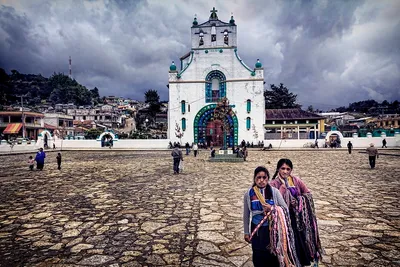
Chamula Chiapas: Mystical Traditions and Cultural Heritage
Chamula Chiapas: Mystical Traditions and Cultural Heritage
Welcome to San Juan Chamula, a captivating village nestled in the heart of the mystical state of Chiapas.
Here, the meeting point of ancient traditions, indigenous spirituality, and vibrant cultural heritage creates an unparalleled tapestry of experiences.
As you step foot into this enchanting place, you’ll find yourself immersed in a world where mysticism and culture collide in the most extraordinary ways.
Chamula, with its rich indigenous history, is a place where time seems to stand still. The village is home to the Tzotzil Mayan people, who have preserved their ancient customs and traditions for centuries.
This cultural resilience shines through in every aspect of daily life, from the vibrant textiles adorning the locals’ attire to the mesmerizing rituals performed in the centuries-old San Juan Chamula church.
What is Chamula Chiapas known for?
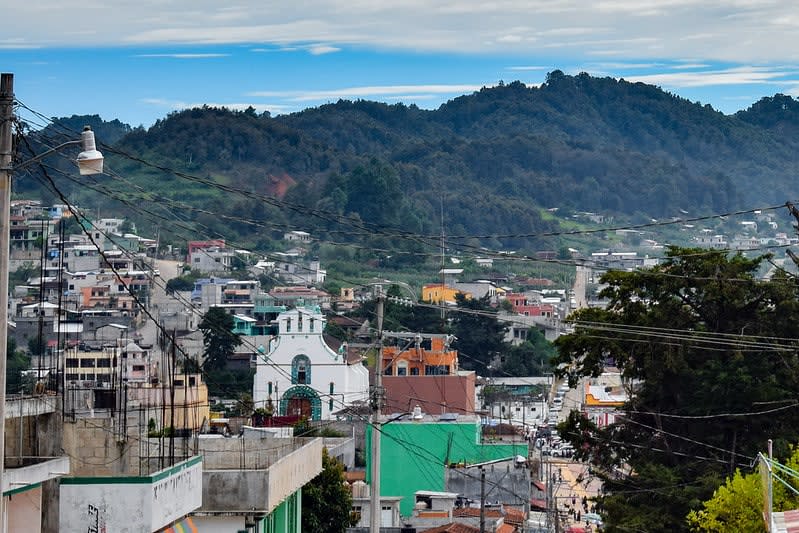
The mystical aura of Chamula is palpable as you wander through its narrow cobblestone streets.
The air is filled with whispers of ancient wisdom and spiritual energy.
The village’s inhabitants, deeply rooted in their beliefs, blend elements of Catholicism with indigenous spirituality, creating a unique syncretism that sets Chamula apart from any other place in the world.
One of the most fascinating aspects of Chamula is its renowned San Juan Chamula church.
Step inside, and you’ll be transported into a realm of awe and wonder.
The church, a testament to the village’s spiritual significance, is adorned with flickering candles, aromatic copal incense, and an assortment of vividly colored flowers.
Witnessing the traditional rituals performed within these hallowed walls is a truly mesmerizing experience—one that offers a glimpse into a spiritual world that transcends cultural boundaries.
Beyond its spiritual allure, Chamula is a rich hub of artistic expression. The Tzotzil Mayan people are renowned for their exceptional craftsmanship, particularly in the creation of intricate textiles and vibrant embroidery.
Exploring the local markets, you’ll be captivated by the kaleidoscope of colors, patterns, and textures that grace the handicrafts on display.
Each piece tells a story, weaving together the threads of cultural heritage and artistic ingenuity.
Climate
San Juan Chamula sits at the highest point of Los Altos de Chiapas (2,260 meters above sea level), which means that on cold days temperatures plummet to around 57 °F.
There’s also a lot of humidity here, especially in summer when it rains the most (May-Oct).
Who are the Chamulas?
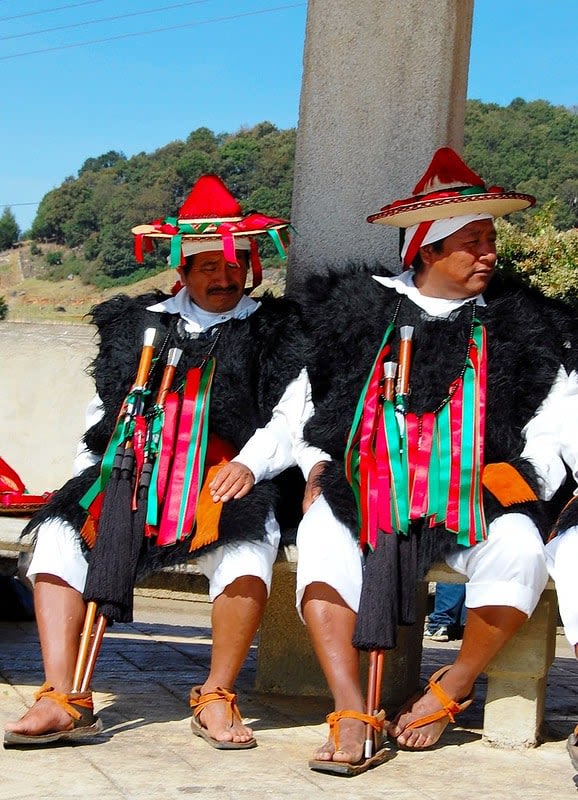
Chamulas is the name given to the indigenous community of Tzotzil ethnicity that lives in the three neighborhoods annexed to the San Juan Bautista Church, San Juan Bautista, and San Pedro – San Sebastián areas.
The designation “Chamula” is used to name various Mayan ethnic groups that inhabit the highlands of Chiapas, from the aforementioned Tzotzil to the Tzeltal, Mame, Tojolabal, and Choles.
It is a population with strong roots that preserve traditions, from the religious to the social or even economic, being the barter still a currency of exchange in the market.
What are the traditions of Chamula Chiapas?
The Chamulas keep traditions, customs, and rituals deeply rooted in their “crazy” culture, a mixture of the pre-Hispanic world, Catholic evangelization, and – of course – globalization.
Religion

In each neighborhood: San Juan Bautista and San Pedro, San Sebastian, there is a cemetery with crosses representing Chul Metic (Mother God) and Chul Totic (Father God).
For the Chamulas, the Catholic religion has a strong presence in their lives.
They are deep believers, but the syncretism between the ancient Mayan deities and the imposition of Catholicism created a very characteristic mixture.
The Catholic Church, aware that certain rites could not be erased with the stroke of a pen, tried to get the indigenous people to assimilate the rites by integrating them into their own.
That is why in the church of San Juan Bautista they make offerings of hens, sacrificed so that their prayers are answered.
Clothing
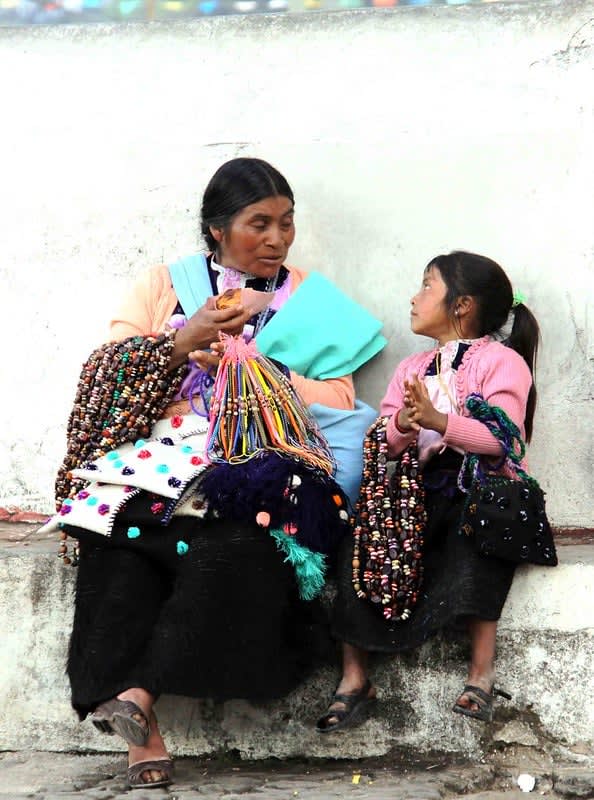
Women always wear thick black skirts made of sheep’s wool, men wear jackets (chuj) of the same material.
Also characteristic is the clothing of the “mayoles” or policemen, whose thick wool chuj is white. They are in charge of bringing peace.
Top 4 things to see in San Juan Chamula, Chiapas
The great plaza (main square) is where everything happens: the market, the meetings to make political decisions, elections, general assemblies, or religious gatherings inside the temple that presides over it.
If you go on market day (Sunday), the esplanade is full of Chamula stalls selling handicrafts, fruits, and vegetables.
1. San Juan Bautista Church
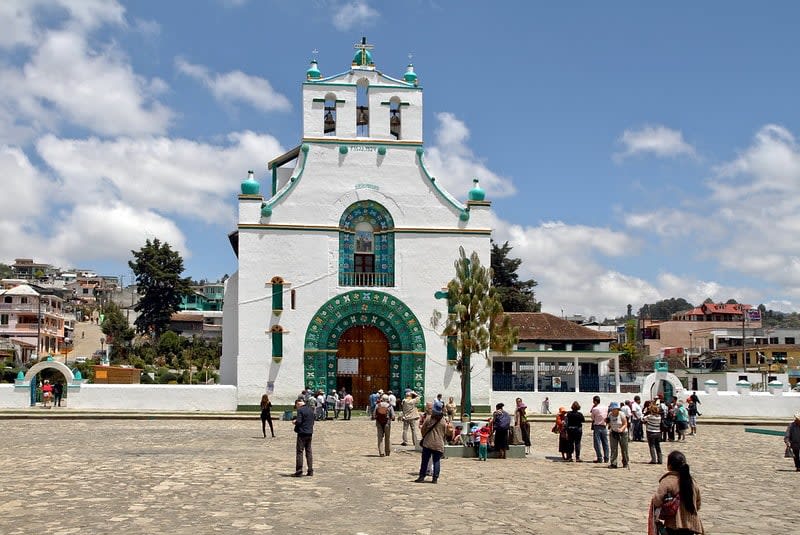
The visit to the interior of the Church of San Juan Bautista must be done with the utmost respect.
It is not allowed to take pictures. After paying your entrance fee, you will be warned vehemently.
Also, you cannot take pictures of the mayordomos (civil and religious authorities of the town), or the authorities, nor the processions, but you can always ask for permission.
The exterior of the temple is whitewashed, with some colorful ornamental trimmings, but it is not the architecture that attracts the curious.
The interior is austere but loaded with symbolism. Lots of candles are always smoldering, and there are no pews.
In the altar area, there are two altarpieces and stained glass windows attached to the walls with images of saints.
Pine leaves (sedge) are spread on the floor and there are usually people kneeling and praying.
If there is a person with health problems they rub herbs and it is common for them to drink pox (pronounced posh, a drink prepared by the Chamulas with a high alcohol content, made with fermented corn and sugar cane).
People who come to pray are usually accompanied by “santeros” who perform the chicken sacrifice ritual.
Offerings of candles, pox, eggs, and even coca cola are given. In its interior, only the rite of baptism takes place, neither marriages nor masses for the dead.
2. Cemetery and Temple ruins of San Sebastian
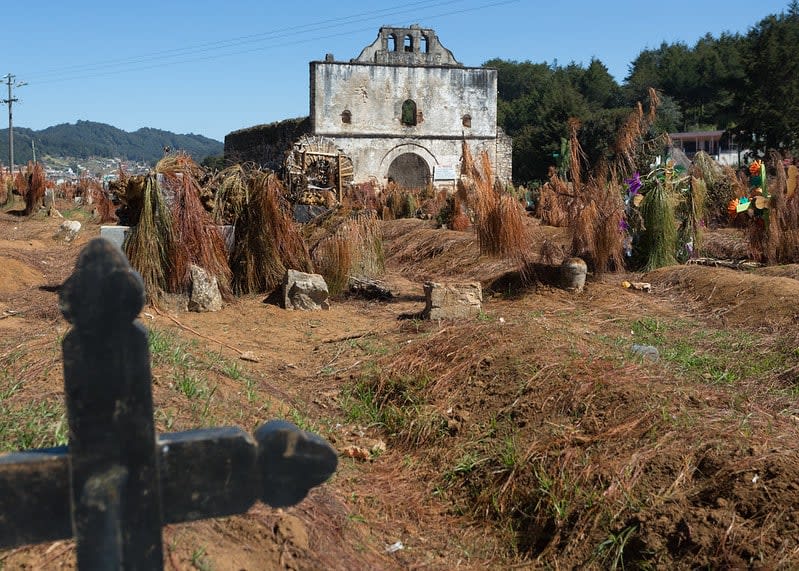
The cemetery and ruins of the old temple of San Sebastian are another must-visit site.
Located on a hill, the cemetery surrounds the temple of which only the walls remain.
The tombs are distributed around, with mounds crowned by wooden or cement crosses (marking the economic possibilities of the deceased).
Next to the crosses are dry pine leaves, whose meaning represents contact with the underworld.
3. Visit the Sunday Market
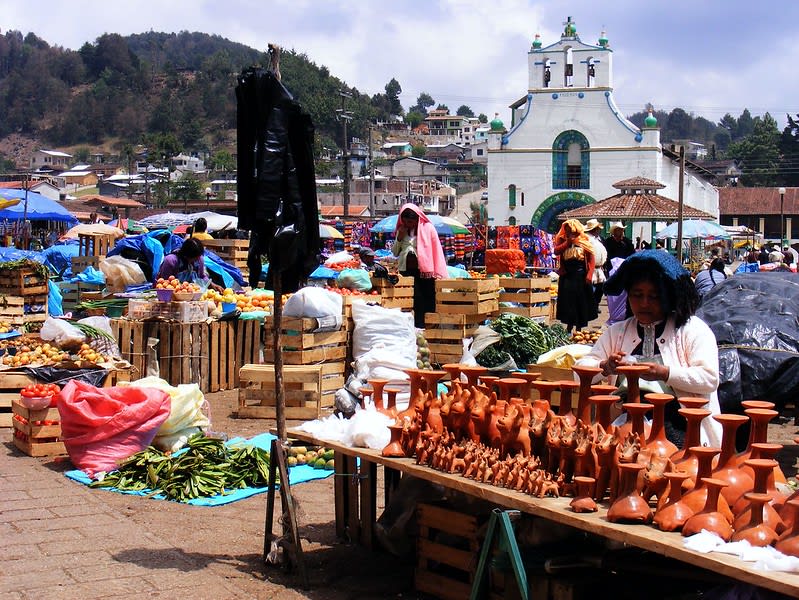
Every Sunday there is a market for handicrafts, wool and cotton textiles, palm hats, leather goods, ceramics, ixtle objects, musical instruments, and wooden objects.
As for the local food, you must try the “chamula” meat and chilacayote (fig leaf squash) sweets.
4. Experience the Carnival
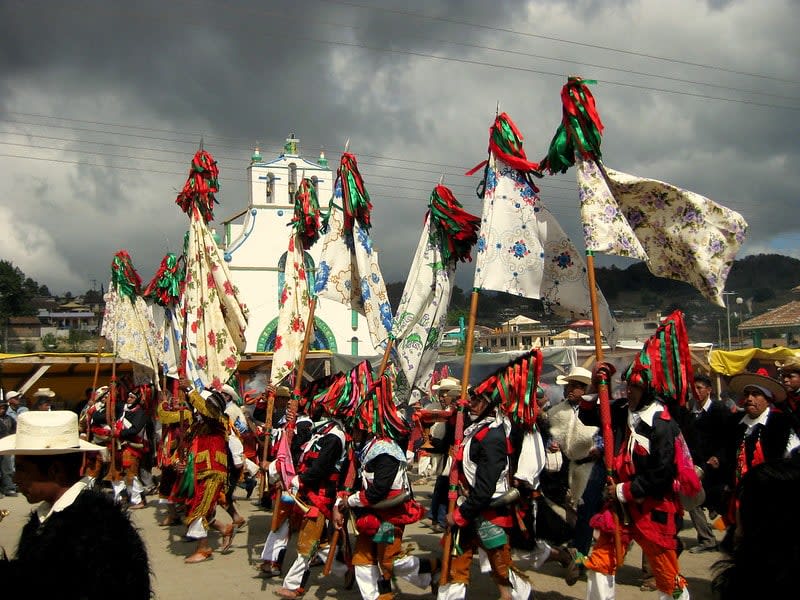
K’in Tajimoltik or “New Fire” in the Tzolzil language, is the most important celebration of the year for the Chamula people.
It is a celebration where Mayan culture is mixed with Christian tradition, combining pagan elements related to fertility and the arrival of spring, with the Catholic rite.
This celebration is related to the five lost days of the Mayan calendar that coincide with the agricultural cycle of fertility in which rituals, ceremonies, and dances were celebrated.
Currently, the Carnival of San Juan Chamula is held during the five days before Ash Wednesday, Tuesday being the most important day when in addition to the traditional parades and dances, 25 bulls are released through the neighborhoods of San Juan and are ridden by the bravest.
Thirteen different groups participate in the Carnival, each with their particular costumes and dances.
The “max,” dressed in wool jackets and frock coats, recalling the clothing of the French military during the War of Intervention, stands out. They wear a conical cap of monkey fur, so they are also known as “monkey-men.”
Chamula’s Carnival has very complex rules, with an incredible allocation of positions and responsibilities.
The “Paxon” stands out among all of them, who is the main charge of the carnival and coordinates the party.
Among all the charges of the celebration and under the baton of the Paxon are organized to make purchases of food and other elements of the party as fireworks, the band, etc.
They are the most experienced elders, and you will recognize them because they always have a glass of “pox,” the traditional drink.
The Mayordomos are elected by each neighborhood of San Juan Chamula and for one year they are responsible for one of the saints of the church.
They are in charge of their “dresses” and offerings and are also responsible for the festivities, paying for them with their money, as well as helping other families if they need it. It is a great pride for the Chamulas to be named Mayordomo.
How to visit Chamula Chiapas?
The distance from San Juan Chamula to San Cristobal de las Casas is only 10 km, and you can choose between different options to get there:
- By Public Transportation: From the Market of San Cristobal de las Casas (Terminal de Colectivos de San Juan Chamula) some buses leave directly at the church of San Juan Chamula in about 30-45 minutes depending on traffic. This is the most economical way to get to San Juan Chamula. These “vans” don’t have fixed schedules and leave when the vehicle is full
- Cabs: This is a quick way to get to San Juan Chamula from San Cristóbal de las Casas. It is advisable to agree on the price before leaving (around 120 pesos one way)
- Organized tour: San Juan Chamula is, along with the Sumidero Canyon, a popular tour. It usually lasts 4 hours, leaving in the morning and returning to San Cristobal de las Casas at noon
Tours and excursions to San Juan Chamula
Excursions to visit San Juan Chamula usually depart from San Cristobal de las Casas or Tuxtla Gutierrez. They usually include in the tour the town of Zinacantán, famous for its flowers and textile handicrafts.
Is it safe to visit San Juan Chamula, Chiapas?
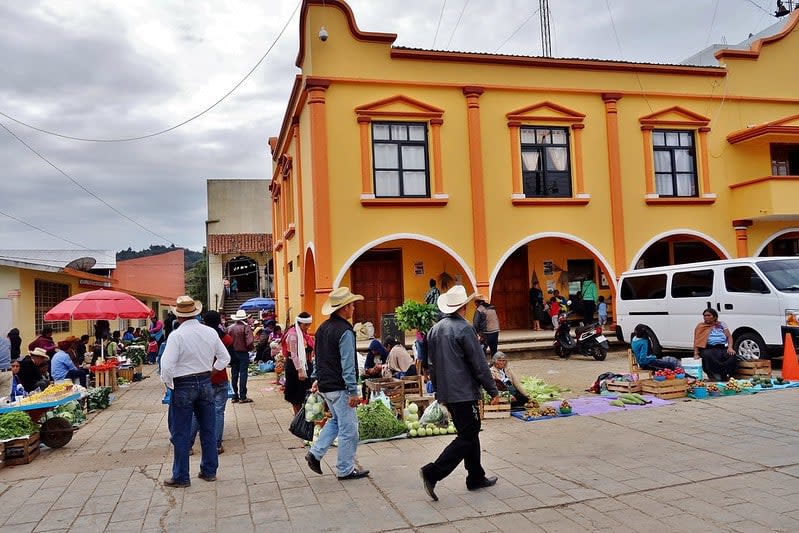
San Juan Chamula has always been much talked about, and its peculiar traditions have added to the legend.
The Chamulas are aware that tourism is their most important source of income, so they really make sure to keep things safe and friendly for everyone.
It is undeniable that the prohibition to take pictures, the firm authorities, or the submissive role of the Chamula women, makes the traveler tend to judge it from their perspective.
In any case, beyond the cultural shock, San Juan Chamula is safe, although it is advisable to be prudent and above all respectful.
Chamula’s gastronomy
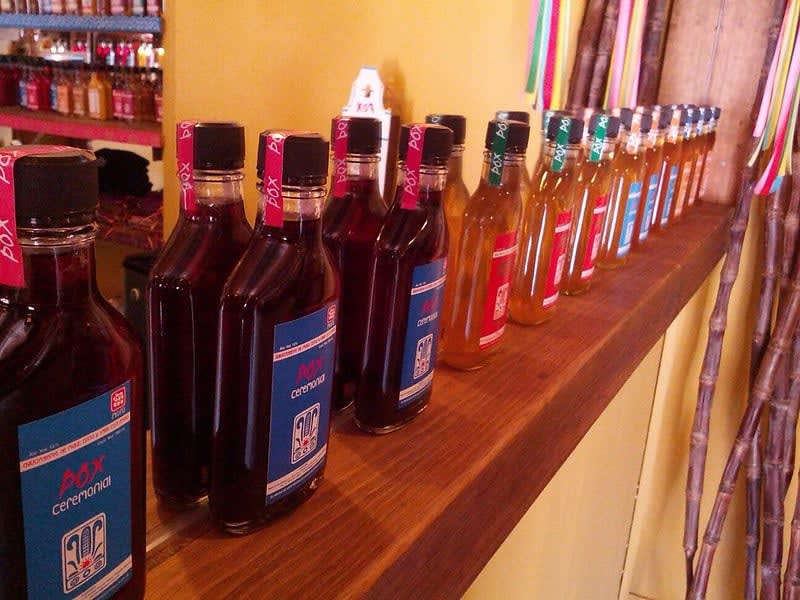
Among the typical dishes are: chicken broth, mushrooms prepared in various ways, beans with green leaves, masa (corn dough) with chicken, rice with pumpkin seeds, and bean tamales.
Typical of San Juan Chamula is a strong alcoholic drink known as pox, pronounced “posh,” an artisanal distillate made primarily from corn and sugar cane.
Pox is mainly used for celebrations or ceremonial acts.
Another drink that is typical in this picturesque town is Vok Ich, which resembles Atole but is a salty drink and is served as a main dish at lunch. It is made with nixtamalized corn dough that is put in a clay pot with water and salt.
Fresh beans with their flowers are added to this mixture heated over firewood.
Sometimes it is seasoned with dried chili and accompanied with tortillas. This is a drink that is used in patron saint celebrations.
Finally, you can not miss the traditional “pozol,” made from yellow corn and cocoa that is kept in banana leaves and accompanied by salt and chili.
San Juan Chamula, Chiapas: Conclusion
As our virtual exploration of Chamula Chiapas comes to an end, we leave behind a place that will forever hold a special place in the hearts of those who visit.
The collision of mysticism and culture in this enchanting village will leave an indelible mark on your soul.
Chamula serves as a testament to the resilience of indigenous communities and their unwavering commitment to preserving their cultural heritage.
The Tzotzil Mayan people have shown us the beauty of syncretism, where the blending of spiritual beliefs enriches their lives and fosters a deep sense of identity.
Chamula Chiapas will forever remain a beacon of mysticism, culture, and human connection—a place where the collision of ancient wisdom and vibrant traditions creates an unforgettable tapestry of experiences.
I invite you to keep the spirit of Chamula alive within you and to carry its lessons as you embark on your adventures in the world.
Thank you for joining me on this journey, and may the mysticism and culture of Chamula continue to inspire and guide you as you explore the vast wonders of Mexico.